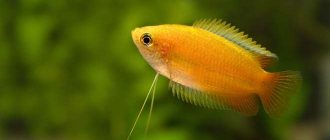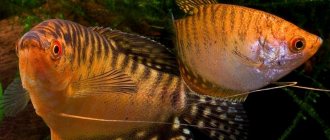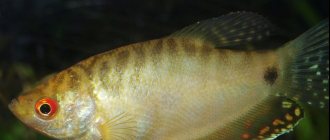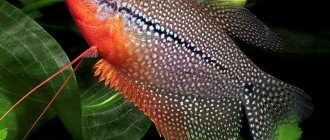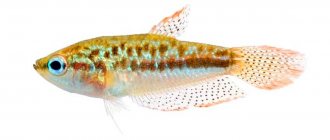The kissing gourami (Helostoma temminkii) has long been very popular in the aquarium hobby. It was first bred in 1950 in Florida and since then it has quickly gained popularity.
And it was discovered and described even earlier in 1829 by a French zoologist. Named after the Dutch doctor Temminck, the full scientific name is Helostoma temminkii.
Every aquarist interested in labyrinths sooner or later encounters a kisser, but now they have lost their former popularity and are not encountered so often.
Habitat in nature
The kissing gourami was first described by Cuvier in 1829 and named after the Dutch doctor Temminck.
Lives throughout Asia - Thailand, Indonesia, Borneo, Java, Cambodia, Burma.
They live in rivers, lakes, canals, and ponds. They prefer standing water with dense vegetation.
Why is this species called kissing? They stand in front of each other and swim slowly for a while, and then lock lips for a brief moment.
From the outside it looks like a kiss; both females and males do this.
It is still unclear why gourami do this; it is believed that this is a kind of test of strength and social status.
In nature there are two color forms, pink and gray, which live in different countries.
However, it is the pink kissing gourami that has become widespread in the aquarium hobby. In the countries where they live, they are fish that are often eaten.
Diseases
Aquarium representatives of the Kissing Gourami are direct descendants of wild populations, which determines their high endurance. Disease outbreaks in a healthy, balanced aquarium are extremely rare and are caused by external causes. However, problems will inevitably arise when living conditions deteriorate, so be careful about timely water replacement and equipment maintenance. Read more about symptoms and treatment methods in the section “Diseases of aquarium fish”.
Peculiarities
- Fish can touch the body of other fish with their lips, damaging the surface
- Intolerant of small fish
Description
The body is strongly compressed, narrow. The pectoral fins are round, large, and transparent.
Body color is pink with shiny scales.
Like other labyrinths, the kisser has a developed organ that allows it to breathe atmospheric oxygen when there is a lack of it in the water.
The most striking feature is the lips. They are large, fleshy and have small teeth on the inside. They often use them to scrape algae off aquarium glass, driftwood and rocks.
In nature it grows up to 30 cm, in an aquarium it is smaller, usually about 15.
Life expectancy is 6-8 years, although cases have been recorded for more than 20 years.
There are two color variations found in nature - gray and pink.
The gray lives in Thailand, its body color is gray-green. The pink one is native to Indonesia and has a pink body color with silvery scales and transparent fins.
The Pink Kissing Gourami is much more common and is more commonly found on sale.
Compatibility
The compatibility of kissing gouramis directly depends on the age and individual characteristics of the particular fish. It is best to purchase young gouramis that have not yet reached sexual maturity. At this age, they are the most peaceful and suitable for keeping in common aquariums with non-aggressive, sized fish. As they grow older, the character of gourami deteriorates; they begin to attack small (and often large) neighbors in the aquarium. If the aquarium volume is insufficient, the number of plants and shelters is small, aggressiveness manifests itself more often. You can keep them with your own kind, but you shouldn’t buy too many individuals. In a pack, kissing gouramis have a very clear hierarchy, and although regular skirmishes rarely lead to death from blows, constant stress in non-dominant individuals weakens them.
Difficulty in content
A beautiful and unpretentious fish that is quite easy to breed. But its size and character make it not very suitable for beginners.
But at the same time, this is a very large fish that needs a spacious aquarium.
In nature they grow up to 30 cm, in an aquarium less than 12-15 cm. And to keep them you need an aquarium of at least 200 liters, preferably even more.
Juveniles are well suited for community aquariums, but adults can be aggressive. They are not as peaceful as other gourami and their character largely depends on the individual.
They don’t bother anyone in the common aquarium; others terrorize their neighbors. Best kept alone or with other large fish.
They are unpretentious fish, but they need an aquarium of at least 200 liters, in addition, they become cocky and territorial with age. Because of this, they are recommended for aquarists with some experience.
Keeping in an aquarium
These gourami are very unpretentious. Although they can breathe atmospheric oxygen, this does not mean that they do not need to change their water.
They suffer from toxins just as much as other fish and require up to 30% water changes weekly. The only thing is, when cleaning the walls of algae, leave the back one untouched; the fish will clean it regularly.
They swim throughout the aquarium, but prefer the middle and upper layers. Since they regularly swallow air from the surface, it is important that it is not tightly covered with floating plants.
The aquarium should be spacious, as the fish grow quite large. Filtration is desirable, but without strong current.
The fish looks better against the background of dark soil, and as decoration you can use stones and driftwood, which will serve as a shelter for the fish.
Plants are optional, but encouraged. However, remember that in nature the species feeds on aquatic plants and will do the same in an aquarium.
It is necessary to plant hard species - anubias, mosses.
Water parameters may vary, but preferably: temperature 22-28°C, ph: 6.0-8.8, 5 - 35 dGH.
Living conditions
The popularity of gourami is due to its extraordinary behavior, which can be admired endlessly - it looks like the fish are kissing. In fact, this is not so, but why gourami do this is not entirely clear. The most popular version is that they simply clean their protruding teeth from plaque and algae. Fish do the same with the walls of the aquarium and shells. You need to keep the fish in the largest possible aquarium, which must be covered with glass.
This is done to prevent the inhabitants from swallowing cooled air.
The gouramis don’t care what kind of soil you choose, but they will definitely appreciate the abundance of algae.
River sand (gray, coarse fraction) is most suitable for plants. Which algae to choose is at the discretion of the aquarist, but it is advisable to calculate everything so that dense thickets form over time. The spawning aquarium must be equipped with duckweed or other floating plants. The fish prefers slightly acidic and soft water (pH6-7, up to 12°dH). The fish is very peaceful and compatible with many different species. The number of gourami themselves must be controlled and sorted by size. The fish feed mainly on plants, so they tend to share territory. Fights for a “place in the sun” take place without injury, but smaller individuals end up constantly persecuted and malnourished.
Breeding
A little more difficult than other types of gourami. They require a large spawning tank and it is difficult to identify the female until she is ready to spawn.
Kissing gourami, unlike other gourami species, do not build a foam nest. They lay eggs under a plant leaf, the eggs are lighter than water and float to the surface.
Once the spawning is completed, the pair loses interest in the eggs and can be removed.
The spawning tank should be large enough, the surface of the water covered with floating plants.
The best way to get a pair is to raise several fish together until maturity (10-12 cm), and feed them heavily with live food before spawning. When they are ready to spawn, the color of both the male and female will become darker, and the female’s abdomen will become rounded from the eggs.
The females are not as round as females of other species, but they are all noticeable enough to distinguish them from the males. From such a group you can choose a couple.
Spawning tank at least 300 liters. The water should have a pH of 6.8 - 8.5, temperature 25 - 28° C. You can install a filter, the main thing is that the flow is minimal.
Plants should float on the surface of the water, and small-leaved species should be planted inside - cabomba, ambulia, pinnate.
The pair you have chosen is placed in the spawning tank. The male begins mating games, swims around the female with fluffed fins, but she runs away from him until she is ready, and it is important that she has somewhere to hide.
After the female is ready, the male hugs her with his body and turns her belly up.
The female releases eggs, and the male inseminates her, the game floats to the surface. Each time the female releases more and more eggs, at first there may be 20, and then reach 200.
Spawning continues until all the eggs are swept away, and the quantity is very large and can reach up to 10,000 eggs.
Although the parents usually do not touch the eggs, sometimes they can eat them and it is better to remove them immediately. The eggs hatch in about 17 hours, and the fry will swim in 2-3 days.
The fry are initially fed with ciliates, microworms and other small foods, and as they grow, they are transferred to artemia nauplii and cut tubifex.
Kissing gourami (lat. Helostoma temminckii) is found in reservoirs of southeast Asia, some countries of Indochina, and on the islands of the Malay archipelago. In nature, fish prefer shallow, quiet ponds with slow currents. They owe their original name to the peculiar movement of their lips and the “kisses” they produce during feeding and mating season.
Structural features of kissing gourami
Gourami can have two color options - gray-green and golden with a pink tint. It is rare to find albinos with red eyes among them. The pink specimens, most often bred by aquarists, have transparent fins. In other varieties, their color may be dark yellow or green. The body of the fish is elongated and slightly flattened on the sides, the eyes are large, the mouth with thick lips is slightly turned up.
Kissing gourami have a unique structure of the oral apparatus - their teeth are located directly on the lips. Thanks to this, the fish are good at scraping algae from plants, and are considered excellent cleaners .
This species belongs to the labyrinth fish with an atypical respiratory system. Thanks to the presence of a special organ located above the gills, gourami can breathe in two ways: oxygen dissolved in the water and oxygen on the surface. This ability helps them survive even in untreated water bodies poor in oxygen.
The lifespan of kissing gourami in captivity reaches 5-7 years. At home, fish rarely grow more than 20 cm in length, while in nature they measure up to 30 cm.
Even experienced aquarists often have difficulty distinguishing between different sexes. The main factor indicating that they are female is considered to be a rounded abdomen during spawning periods. Males have a slightly convex forehead, their body is more flattened on the sides, and in the mating season the color becomes brighter and darker, with a purple tint.
Kinds
On the outer surface of the lips of this fish there are small growths similar to teeth. The body is compressed from the sides, the head smoothly flows into the body. The mouth is slightly elongated vertically, the lips are thick. With improvised teeth, the gourami scrapes off all organic matter from glass, shells, stones, and everything that it finds in the aquarium. There are mainly two colors of gourami: gray-green and pink. The first color predominates in Thailand; horizontal stripes are visible on the body, and the fins are brown. The second color is more rare; it is found in fish on the island of Java and Indonesia. Some experts consider yellow gouramis to be a separate species; albino gouramis are often found. The male is not too different from the female; only a person experienced in this matter will notice small differences. The male has a slightly convex forehead, and the body is more flattened on the sides. During the mating season, the male becomes brighter in color. Females are slightly larger, but this is almost invisible to the eye. Spawning is stimulated by reducing hardness and heating the water by 2-3°C. Spawning begins in the evening with “kisses” - the male and female touch their lips and remain in this position for a long time. In the video you can see that the male is hugging the tail part of the female with his body, as if squeezing the eggs out of her with his embrace. With each subsequent embrace, the female begins to play more and more. Kissing gouramis are unpretentious fish. Their prices are affordable for every aquarist, and you can watch the “kisses” of these wonderful fish for hours.
Some ornamental fish are valued by aquarists not for their catchy coloring and spectacular appearance, but for their unusual behavior, which can be regularly observed in the aquarium. One of these species is This fish was first described at the beginning of the 19th century, but it was only possible to reproduce it in captivity in 1950.
Feeding and maintenance
This variety is quite unpretentious, so difficulties in keeping kissing gourami arise only for inexperienced aquarists. To keep your fish in active shape, it is important to monitor their balanced diet. The kissing gourami is a predator, but its menu should also include traditional dry food.
The diet of these fish must include:
- small tubifex;
- cyclops;
- dry daphnia;
- shrimps;
- worms and insect larvae;
- snails
With a moderate appetite, gourami eat bloodworms and hunt fry with pleasure. For the normal state of their health, feeding with algae (filamentum, spirulina), plant components (lettuce, cabbage, spinach, finely chopped cucumbers treated with boiling water) is important.
To keep 2-3 kissing gouramis you will need a spacious vessel with a volume of 50-150 liters. Their housing should also be quite spacious.
To prevent losses, two males should not be in the vessel at the same time. During spawning, gourami are capable of severely injuring each other . The best option for setting up an aquarium is several females (2-3) and one male.
When choosing a place to locate an aquarium, you need to consider the following - kissing gourami are thermophilic and cannot stand the cold. These gentle creatures can catch a cold from the slightest draft, resulting in the rapid death of the entire livestock. The container with them should be located in places protected from cold air currents and covered with a lid.
Lighting should be dim. Gourami will not be able to stay in the water in bright light and will become irritable and depressed.
Water indicators should be as follows:
- acidity level – 6-7;
- temperature mode – 22-26 °C (25 is best);
- hardness up to 12.
Gourami will require a lot of dense bushes, snags for shelter and an area for free movement. It is best to cover the bottom of the aquarium with coarse river sand, which, gradually silting, becomes suitable for the growth of vegetation (vallisneria, Canadian elodea, Thai fern). Pebbles or coarse gravel also work well for this purpose. During the spawning period, it is necessary to fill the aquarium with floating plants (duckweed or riccia).
Despite the ability of fish to breathe ordinary air, aeration of the aquarium is mandatory. Filtration and water changes every week (25-30% of the total volume) are also important.
Breeding kissing gourami
Sexually mature gouramis are at least 10-12 cm in length. They become such at the age of 1.5-2 years. A sign of readiness for reproduction will be a darkened color in males and a rounded abdomen in females. Before spawning, gourami should primarily feed on live food (bloodworms).
To breed this variety, it is necessary to separate the selected pair from the rest into a spawning tank. It should have a considerable volume - up to 300 liters, water temperature - within 25-28 degrees. You will need to place floating plants (ambulia, pinnate) on the surface of the vessel. They are necessary so that the female has the opportunity to hide during mating games. The current in the spawning tank is set to a minimum.
Video: kissing gouramis in a spawning area
When the female releases eggs, the male instantly inseminates her, and the eggs appear on the surface. At one time, the female produces up to 200 eggs, and over the entire spawning period up to 10 million.
Kissing gouramis are not ideal parents, and do not make foam nests . Females lay eggs directly under green leaves. After the process is completed, the pair should be removed immediately, since both fish are capable of eating their own offspring with appetite.
The fry are born within 24 hours, and after 2 days they begin to swim. Immediately after birth, they must be fed microworms and ciliates. Gradually, brine shrimp and chopped tubifex are introduced into the diet.
The labyrinthine organ of young gourami develops only after 2-3 weeks from the moment of their birth. In this regard, the water for keeping the fry must be saturated with oxygen.
